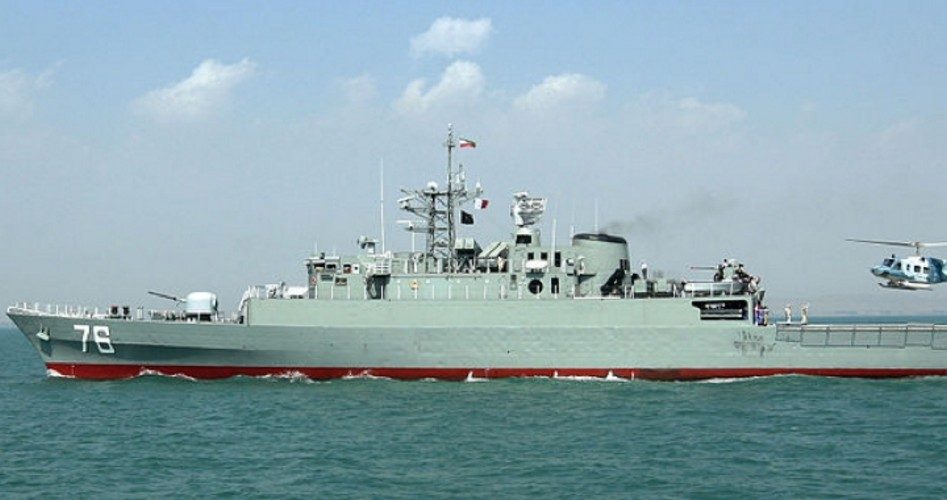
Iran’s semi-official news agency, Fars, quoted a statement from Iranian Naval spokesman Admiral Afshin Rezayee Haddad on February 8 announcing that Iran is sending “a number of” warships to sail near the U.S. Atlantic Coast.
“Iran’s military fleet is approaching the United States’ maritime borders, and this move has a message,” said Haddad — the commander of the Iranian navy’s northern fleet — adding that the Iranian ships were approaching the Atlantic Ocean “via the waters near South Africa.”
The “message” Iran wishes to send, according to Fars, is that if the United States can increase its naval presence in the Persian Gulf, then Iran will stage a presence near the United States. The decision to send ships near the United States is “Iran’s response to Washington’s beefed up naval presence in the Persian Gulf.”
The U.S. Fifth Fleet is based in Bahrain, a tiny island nation on the western edge of the Gulf, off Saudi Arabia. The fleet regularly engages in naval exercises in the Gulf with its allies, with the stated intention of protecting freedom of navigation in the waterway through which 40 percent of the world’s oil shipments pass.
A U.S. military official told CNN that our military had no operational information to verify Iran’s statement.
“They do send some ships from time to time to the Gulf of Aden [between Yemen, in the Arabian Peninsula, and Somalia, in the Horn of Africa] for unilateral counter piracy operations. In theory, a couple of ships could go there and then off south down towards the cape [of Good Hope],” CNN quoted the official, who also said it is the first time Iran has threatened to send its ships near U.S. maritime borders.
“It’s important to understand that, at this point, we have an announcement not a deployment. They’ve stated this aspiration before,” said the official, speaking on condition of anonymity because of the sensitivity of the matter.
Reuters also quoted an anonymous U.S. defense official (though it is not known if it is the same official quoted by CNN) who said about the Iranian announcement that “ships are free to operate in international waters.”
By international law, nations generally consider waters up to 12 nautical miles from their shores as territorial waters. Nations also exercise limited control over a contiguous zone extending from the outer edge of the territorial sea up to 24 nautical miles from the shoreline, within which a state can exert limited control for the purpose of preventing or punishing “infringement of its customs, fiscal, immigration or sanitary laws and regulations within its territory or territorial sea.”
The Strait of Hormuz, through which ships pass to enter the Persian Gulf is, at its narrowest, 21 nautical miles wide. When passing through the Strait, ships pass through the territorial waters of Iran and Oman under the transit passage provisions of the United Nations Convention on the Law of the Sea. Although the United States has not signed the LOS convention (over justifiable concerns that the LOS represents a threat to U.S. sovereignty), it observes the navigation rules as codified in the Convention.
Iran does not recognized the right of nations that have not signed the LOS Convention to transit passage through the Strait of Hormuz. When signing the Convention in 1982 Iran made a declaration stating, in part:
It seems natural … that only States parties to the Law of the Sea Convention shall be entitled to benefit from the contractual rights created therein. The above considerations pertain specifically (but not exclusively) to the following: The right of transit passage through straits used for international navigation.
On April 30, 1987, the Algerian Embassy in Washington delivered a Diplomatic Note relaying a message from Iran concerning the right of transit passage through the Strait of Hormuz that cited an alleged violation of claimed Iranian territorial waters by U.S. ships. The United States replied to the Iranian note, in part:
The United States … particularly rejects the assertions that the … right of transit passage through straits used for international navigation, as articulated in the [LOS] Convention, are contractual rights and not codification of existing customs or established usage. The regimes of … transit passage, as reflected in the Convention, are clearly based on customary practice of long standing and reflects the balance of rights and interests among all States, regardless of whether they have signed or ratified the Convention.
While Iran’s objection to the U.S. naval presence in the Persian Gulf may have prompted its decision to send naval ships off the U.S. coast, the operation has more diplomatic than military significance. Though generally described as a “fleet” in media headlines, reports from the Iranian media indicate that the nation is sending only two ships — a destroyer and a helicopter transport vessel — on the voyage.
Back in September 2011, the commander of Iran’s navy, Rear Admiral Habibollah Sayyari, announced that Iran would begin a naval buildup “near [the] maritime borders of the United States.”
“Like the arrogant powers that are present near our maritime borders, we will also have a powerful presence close to the American marine borders,” said Sayyari.
If the current operation is meant to intimidate the United States and cause it to back off from its Persian Gulf operations it must be an example of saber-rattling lite. According to GlobalSecurity.org, the U.S. Fifth Fleet that operates in the Persian Gulf and surrounding areas usually has a force of 20 or more ships, including a Carrier Battle Group, an Amphibious Ready Group, combat aircraft, and other support units and ships. That fleet alone is considerably more powerful than all of Iran’s military forces combined — air, land, and sea.
As for an Iranian destroyer and helicopter transport vessel presenting a serious threat to our Atlantic seaboard, consider what GlobalSecurity.org reports about our Atlantic Fleet, known for operational purposes as the 2nd Fleet: “The Atlantic Fleet consists of over 118,000 Sailors and Marines, 186 ships and 1,300 aircraft.”
The Atlantic Fleet has three regional commanders based in New London, Connecticut; Norfolk, Virginia; and Jacksonville, Florida. The fleet has five aircraft carriers assigned to it, with one or two generally assigned to either the Sixth Fleet in the Mediterranean or the Fifth Fleet in the Persian Gulf. A carrier strike group typically consists of (in addition to the carrier), one Guided Missile Cruiser, two LAMPS (Light Airborne Multipurpose System) Capable Warships, and one or two Anti Submarine Destroyers or Frigates.
As the United States Navy Fact File notes: “Aircraft Carriers support and operate aircraft that engage in attacks on airborne, afloat and ashore targets that threaten free use of the sea; and engage in sustained power projection operations in support [of] U.S. and coalition forces. The aircraft carrier and its strike group also engage in maritime security operations to interdict threats to merchant shipping and prevent the use of the seas for terrorism and piracy.”
The United States has 10 aircraft carriers, 61 destroyers, 24 frigates, and 71 submarines, all of which are nuclear powered. The Iranian navy has no aircraft carriers, three destroyers, nine frigates, and 29 submarines, all of which are diesel-electric powered.
The strategic advantage of the United States over Iran’s navy is so unbalanced that any threat presented by Iran is limited to propaganda purposes. Any engagements between U.S. and Iranian vessels would be even more one-sided than Britain’s overwhelming superiority over Argentina’s during the 1982 Falklands War.
Americans can sleep soundly without fearing that our East Coast is in imminent danger from an attack by an Iranian “fleet.”
Photo of Iranian Jamaran-class destroyer


